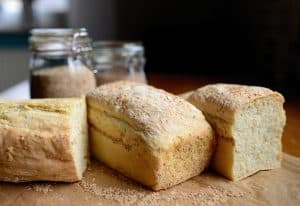The ingredients of bread
The main ingredient of bread is flour, usually made from wheat. Bread also contains water, yeast, salt, sugar, milk, egg, and oil or fat.
Flour typically contains gluten, which is a protein composite found in foods that have been processed from wheat and other grains. Gluten might cause various symptoms, in this article we are going to focus on that.
There is a wide variety of gluten-free bread recipes and most supermarkets offer all kinds of gluten-free breads. Wheat is usually substituted with flour made from amaranth, almond, coconut, oat, etc.
Stomach pain after eating bread
Bread is a common trigger of digestive issues. Sometimes the problem is simply eating too much bread or eating it too hot. Hot bread doesn’t digest and might cause indigestion.
However, sometimes there is an underlying medical condition that triggers stomach pain after bread intake:
- gluten intolerance, allergy, or celiac disease
- irritable bowel syndrome (IBS) – sometimes bread might be a trigger food, causing constipation
- gallstones, inflammation of the gallbladder or pancreas
- heartburn
When bread causes gut problems, these are the most common symptoms:
- stomach cramps
- either diarrhea or constipation
- abdominal pain
- nausea, vomiting
Why do you have chest pain after eating bread?

Chest tightness after eating bread can be a symptom of gluten sensitivity or intolerance, but heartburn, gallstones, or pancreatitis might also be the culprit.
The most common reason for chest and stomach discomfort caused by bread is its gluten content.
Gluten is a compound that is very hard for the human body to digest. It usually requires a powerful acid for it to be digested, and when you have a meal that mainly contains wheat, digestion can take a very long time.
Whenever you eat something hard to digest, it makes your digestive system work harder than normal. This is usually not a problem for most of us, however, if you already have digestive problems, eating bread might cause you symptoms like:
- chest pain
- heartburn
- stomach pain
- bloating
- vomiting
- nausea
- diarrhea
These are the most common health conditions that can cause chest or stomach pain after eating bread:
- eating too much
- acid reflux
- gallbladder disease
- pancreatitis
- celiac disease, wheat allergy, and gluten sensitivity
Esophagus pain when eating bread

When experiencing pain around the center of the chest after eating bread, the issue is often in the esophagus.
These are the most likely causes of bread-related esophageal pain:
- Food bolus: Bread can form a food bolus in the esophagus. In most cases, such boluses pass spontaneously. However, 10% – 20% of the cases might require intervention.
- Heartburn: Those who are prone to acid reflux, might have heartburn after eating bread. In this case, stomach acids flow back (reflux) into the esophagus, irritating the lining of the food pipe.
- Eosinophilic esophagitis: Eosinophilic esophagitis is an immune system disease and might trigger the inflammation of the esophagus, which can be the cause of painful swallowing.
Heartburn after eating bread
Since bread is hard to digest, it stays longer in the stomach and triggers the secretion of more stomach acids. This increases the risk of an acid reflux episode, especially for GERD sufferers.
The bread stays about 3 hours in the stomach before moving into the small intestines. (As a comparison, most fruits and vegetables stay about 40 minutes in the stomach, while red meat needs 3-5 hours.)
As bread spends so much time in the stomach, the chances of digestive juices being able to seep up into the esophagus are higher. When the highly acidic content of the stomach irritates the lining of the esophagus, you feel a burning sensation in the chest, called heartburn.
Diets that are high in carbohydrates have been known to aggravate the symptoms of acid reflux. This study found that both total reflux time and the number of long reflux periods are significantly more after meals that have high carbohydrate content.
Some people have trouble digesting certain types of bread since they contain a lot of gluten. The wrong choice of bread can cause the digestive system to get overworked owing to the gluten content.
Can gluten cause chest and stomach pain?
Yes, in many cases, chest or stomach pain after eating bread might be an allergic reaction or a symptom of intolerance to gluten.
Gluten intolerance and chest or stomach pain
Also called non-celiac gluten sensitivity, or gluten sensitivity. The exact mechanism of gluten intolerance is not fully understood, but many people who are tested negatively for celiac disease, still produce symptoms when eating foods that contain gluten.
Common symptoms are gas, bloating, stomach cramps, and diarrhea.
While gluten intolerance often causes stomach pain, chest pain is less typical. However, those who have gas or bloating after eating bread might also experience chest pain.
Unlike celiac disease, gluten sensitivity does not seem to cause small intestine damage.
Celiac disease & chest/stomach pain
Celiac disease is the abnormal reaction of the immune system when eating foods that contain gluten. Not only wheat but barley and rye can also trigger symptoms.
The most common symptoms are
- stomach pain
- diarrhea
- vomiting
- bloating
- nausea
Celiac disease is another condition that is more likely to trigger stomach pain than chest pain.
Some people might also have symptoms not related to the digestive system.
If left untreated, celiac disease can cause serious health problems in the long term.
There is no known cure for celiac disease, the only way to avoid both short-term symptoms and long-term health issues is to maintain a gluten-free diet.
Wheat allergy
Allergic reactions are abnormal responses from the immune system to certain foods. In this case, it is the protein in the wheat that triggers symptoms.
Symptoms can be as mild as sniffing, runny nose, itchy eyes. More serious symptoms are stomach cramps, nausea, and vomiting. Severe symptoms are breathing difficulties, swelling of the throat and airways. This is called anaphylaxis and requires immediate medical help.
In case of allergic reactions, symptoms usually appear a few minutes after eating bread.
Eating too much
Eating too much food is very common in the developed world. Chest pain after eating too much affects most of us at least a few times during our lives.
If you had a large meal and experience chest pain after it, the reason might be overeating. As long as the chest or stomach pain is very occasional and happens after large meals, you might not need to do anything but try to limit the amount you eat.
However, regular eating-related chest or stomach pains might indicate more serious health problems.
Pain on the left or right side after eating bread
Gallbladder problems usually cause pain in the right side of the body, while left side pain after eating might originate from the pancreas.
The gallbladder is a small organ located under your liver in the upper right part of the abdomen. It stores the bile produced by the liver and pushes it into the small intestines to help digestion.
The pancreas is located in the upper left part of the abdomen. The pancreas produces enzymes that are required for properly digesting food. These are also released into the small intestines when needed for digestion.
Whenever you eat hard-to-digest foods and have gallbladder diseases – like inflammation or gallstones -, or problems with your pancreas – like pancreatitis -, the release of bile or enzymes might be a painful process. The most common symptom is a very sharp pain in the upper right or left part of the stomach, which can radiate into the back, shoulder, neck, or arm.
Other symptoms are:
- heartburn, chest pain
- vomiting
- nausea
- fever
- yellowing of the skin and eyes
- tea-colored urine and light-colored stools
If your symptoms last for a few hours, you need to get medical attention.
If eating bread typically produces symptoms only on the right or left side, gallbladder problems or pancreatitis might be the possible culprit.
Back pain after eating bread
Back pain after eating is usually a referred pain, meaning the location and the origin of the pain are different.
In most cases, it’s either the stomach or chest that hurts and pain radiates into the back.
Common conditions that might trigger back pain after eating bread:
- Heartburn: Pain might radiate into the center of the back, between the shoulder blades.
- Gallstones: Pain is typically felt on the right side of the back. Often the right shoulder is also affected.
- Pancreatitis: Left side back pain is the possible symptom in this case.
- Gluten: Gluten often has an inflammatory effect on people who are sensitive to it. In such cases, joint pain might be a possible symptom and a possible trigger of back pain.
Shortness of breath after eating bread
Eating bread might trigger shortness of breath for various reasons:
- Blood sugar: Bread, especially white bread, has a high glycemic index. This means it can cause sudden changes in the blood sugar level and shortness of breath might be a symptom of that.
- COPD: People suffering from COPD (chronic obstructive pulmonary disease) might experience shortness of breath after eating large meals. Since bread is hard to digest, it can trigger symptoms.
- Gluten allergy: Shortness of breath is a possible symptom of allergic reactions. Allergy-induced breathing problems might be very serious, people with this condition should avoid gluten.
Final thoughts
Eating bread can trigger various symptoms for some people. Such symptoms might be diarrhea, stomach cramps, nausea, vomiting, chest pain. Sometimes eating bread can even trigger back pain (which is usually a radiated pain).
There are several health issues that could cause such symptoms. The most common are acid reflux, allergy, and intolerance. Sometimes other parts of the digestive system, like the gallbladder or the pancreas, might be the culprit.
If bread causes chest pain after eating, the best thing you can do is to reduce or completely eliminate bread from your diet. Some experts recommend doing that even if you have no symptoms at all, however, most experts don’t see any evidence that going gluten-free is beneficial in such cases.
Frequently asked questions
Accidentally eating moldy bread can cause all kinds of problems. From vomiting, and diarrhea to more serious food poisoning.
Depending on the strength of your immune system, you might be able to digest a small amount of mold, but if you are experiencing any symptoms after eating moldy bread, you should call your doctor right away!
More than 2 slices per meal are not recommended. However, even this might be way too much if you are on a low-calorie diet.
For example, if you are on a 2,000 calorie diet, WebMD recommends one bagel per day.
It is also important to eat whole grain instead of white bread.
Eating too much bread (or too much of anything, for that matter) can make you gain weight.
The high fiber content of whole-grain breads make you feel full sooner, so it is hard to eat too much of them. This is one more reason to choose whole grain over white bread.
